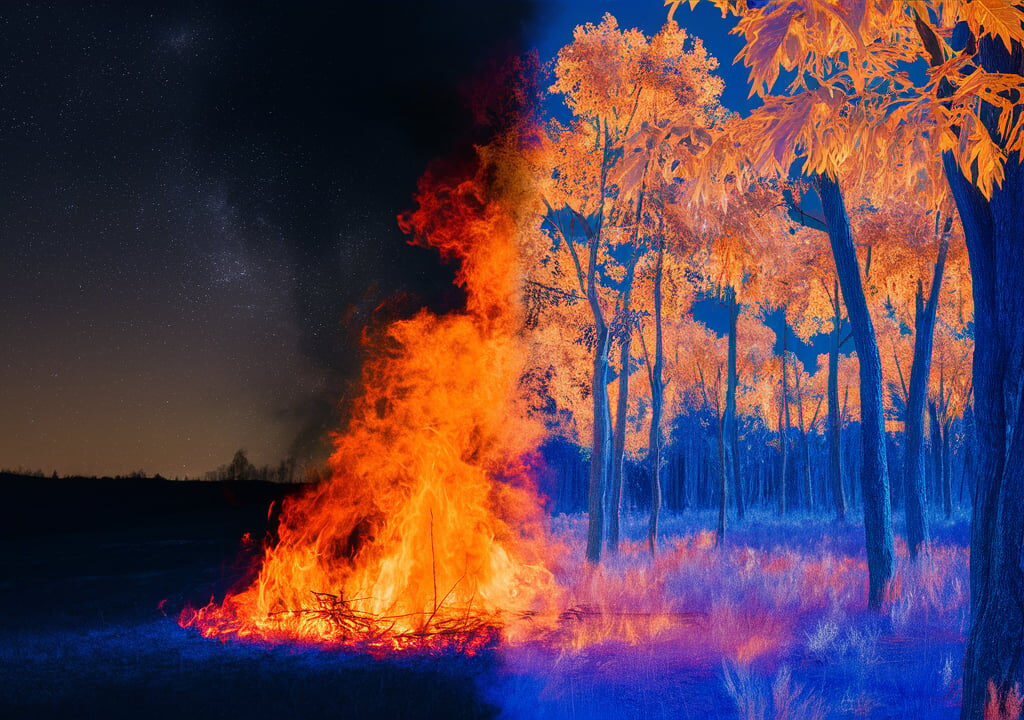Thermal imaging is a versatile technology. It is used in both home inspections and by hobbyists.
Comparing these uses can help you understand its benefits better. Home inspections and hobbyist activities both benefit from thermal imaging. In home inspections, it detects issues like heat loss, electrical problems, and water leaks. Hobbyists use it for various interests, such as wildlife observation or DIY projects.
Understanding the differences and similarities helps make informed choices on using thermal imaging effectively. This comparison will highlight practical applications, cost considerations, and ease of use, providing a clear guide for those interested in either professional or personal use. Discover how thermal imaging can serve your needs in different contexts.
Introduction To Thermal Imaging
Thermal imaging technology has become more accessible over the years. It’s used in various fields, including home inspections and hobbyist activities. Understanding the basics of thermal imaging is essential for anyone looking to utilize this technology effectively.
What Is Thermal Imaging?
Thermal imaging is a technique that captures and creates images using infrared radiation. All objects emit infrared radiation as heat. Thermal cameras detect this radiation and convert it into visible images. These images display temperature variations, allowing us to see heat patterns. This ability is crucial for identifying issues not visible to the naked eye.
Importance In Modern Applications
Thermal imaging is vital in many modern applications. In home inspections, it helps detect hidden problems like water leaks and insulation gaps. These issues can lead to higher energy costs and potential damage. Identifying them early saves time and money. For hobbyists, thermal imaging offers a unique way to explore the world. They can use it for activities such as wildlife observation or electronics projects. The ability to see temperature differences adds a new dimension to their hobbies. This technology has applications in many fields, making it a valuable tool for both professionals and enthusiasts.
Home Inspections With Thermal Imaging
Thermal imaging has revolutionized home inspections by providing a non-invasive method to identify hidden problems that traditional inspection techniques might miss. As a homeowner, you might wonder how this technology can benefit you during a home inspection. Let’s delve into how thermal imaging can make a difference by identifying structural issues and detecting moisture and leaks.
Identifying Structural Issues
Structural issues can be a nightmare for homeowners. They might start small but can lead to significant damage over time. With thermal imaging, inspectors can easily spot temperature variations that indicate potential problems. For example, if there’s an area in the wall that is cooler than the rest, it could signify a lack of insulation or even a hidden void.
During my own home inspection, the thermal camera revealed an unusual cold spot on the ceiling. The inspector explained that this could be due to improper insulation. Without this technology, I might have faced hefty heating bills or even structural damage in the future. Thermal imaging thus helps you catch issues early, saving you money and stress.
Detecting Moisture And Leaks
Moisture and leaks are often hard to detect until they cause visible damage like mold or water stains. Thermal imaging can pinpoint these issues by identifying areas with abnormal thermal patterns. A warmer spot on a wall could indicate a hidden leak from a pipe, while cooler areas might show moisture accumulation.
Imagine walking into your basement and finding it unexpectedly dry, yet you notice a persistent musty odor. A thermal camera can identify moisture behind walls or beneath floors, which might be the source of the smell. In my previous home inspection, thermal imaging revealed a hidden leak in the bathroom wall. This early detection prevented extensive water damage and mold growth.
Thermal imaging in home inspections is not just about finding problems; it’s about preserving your peace of mind. Wouldn’t you want to know that your home is safe and sound? By identifying structural issues and detecting moisture and leaks, thermal imaging ensures that you are making a well-informed decision about your property.
Have you ever had a home inspection with thermal imaging? How did it help you? Feel free to share your thoughts and experiences in the comments below!
Benefits Of Thermal Imaging In Home Inspections
Thermal imaging technology has revolutionized the way home inspections are conducted. It provides unique insights that are often invisible to the naked eye, ensuring homeowners can identify and address issues before they become major problems. Below, we delve into the key benefits thermal imaging brings to home inspections.
Improving Inspection Accuracy
Accuracy is crucial in home inspections. Traditional methods may miss hidden issues, but thermal imaging excels in detecting anomalies. Imagine you’re buying a house and want to ensure it’s in top condition. Thermal cameras can reveal:
- Water leaks: Spotting moisture behind walls or ceilings that could lead to mold.
- Electrical faults: Identifying overheating circuits that might pose fire risks.
- Insulation deficiencies: Finding areas where heat is escaping, leading to higher energy bills.
Using thermal imaging, inspectors can provide a more comprehensive report, giving you peace of mind about your investment.
Preventing Future Problems
Thermal imaging isn’t just about identifying current issues; it also helps in foreseeing future problems. Imagine moving into a home only to discover hidden defects months later. With thermal imaging, inspectors can:
- Assess HVAC systems: Detecting inefficiencies in heating and cooling systems.
- Check structural integrity: Identifying areas where the building might be losing heat, suggesting potential structural issues.
- Spot pest infestations: Recognizing unusual heat patterns that could indicate pests.
By identifying these issues early, you can take proactive measures, saving time and money in the long run.
Have you ever wondered how much easier life would be if you could foresee problems before they arise? Thermal imaging in home inspections offers this advantage, ensuring your home remains safe, efficient, and comfortable.
So, next time you’re considering a home inspection, ask yourself: Can you afford to skip the benefits of thermal imaging? The answer might just save you from unexpected headaches down the road.
Hobbyist Use Of Thermal Imaging
Thermal imaging helps hobbyists find heat differences in everyday items. It contrasts sharply with home inspections, where professionals detect structural issues. Both uses benefit from identifying hidden problems.
## Hobbyist Use of Thermal Imaging Thermal imaging technology isn’t just for professionals conducting home inspections. It’s also a thrilling tool for hobbyists who want to explore a variety of activities. Whether you’re into DIY projects, gadgets, or wildlife observation, thermal imaging can add an exciting layer to your hobbies. ###Diy Projects And Gadgets
Are you a DIY enthusiast? Thermal imaging cameras can help you with your projects in numerous ways. They allow you to identify heat leaks in your homemade gadgets or even check the efficiency of your custom-built cooling systems. Imagine working on a new electronics project and being able to see which components are overheating in real time. It makes troubleshooting so much easier. Have you ever had a drone? Attach a thermal imaging camera to it and you can spot heat signatures from the sky. This can be particularly useful for checking the thermal performance of solar panels you might have installed. You can also inspect your home insulation or plumbing for leaks without tearing down walls. ###Wildlife Observation And Tracking
If you love nature, thermal imaging opens up a whole new world. You can track nocturnal animals without disturbing them. Imagine being able to spot a deer hidden in the bushes during your evening hike. It’s like having a superpower! Thermal imaging is also incredibly useful for bird watchers. You can observe birds in their nests at night without using bright lights that might scare them away. Ever thought about how fascinating it would be to track the nightly activities of a family of raccoons in your backyard? With a thermal camera, you can. Thermal imaging can also help you understand animal behaviors better. By tracking their heat signatures, you can study their movement patterns and habitat preferences. Isn’t it exciting how much more you can do with your hobbies when you add thermal imaging into the mix? What interesting applications could you come up with? The possibilities are almost endless.Comparing Professional And Hobbyist Equipment
When it comes to thermal imaging, the equipment you choose can make a significant difference in the results you achieve. Whether you’re a professional home inspector or a hobbyist, understanding the differences in the tools available is crucial. In this section, we’ll delve into the key distinctions between professional and hobbyist thermal imaging equipment, focusing on three critical aspects: cost and accessibility, resolution and accuracy.
Cost And Accessibility
Professional thermal imaging equipment tends to be more expensive than hobbyist tools. These high-end devices are designed for rigorous and frequent use, often costing several thousand dollars. They come with advanced features, comprehensive warranties, and excellent customer support.
On the other hand, hobbyist thermal imagers are more budget-friendly. You can find decent models for under $500. They are widely accessible online and in electronic stores. However, these devices might lack some of the advanced features found in professional equipment. Consider what you need the device for. If you’re only using it occasionally around the house, a hobbyist model may suffice.
Resolution And Accuracy
Resolution and accuracy are where professional and hobbyist thermal imagers differ significantly. Professional-grade tools offer higher resolution and greater accuracy, which are essential for detecting subtle temperature differences and identifying potential issues in home inspections.
Hobbyist thermal imagers, while improving, often have lower resolution and less accurate readings. This might be adequate for casual use, like checking for drafts or spotting wildlife in your backyard. However, for more precise tasks, such as diagnosing electrical problems or assessing insulation performance, you need the enhanced capabilities of professional equipment.
Have you ever tried using a hobbyist thermal imager for a detailed task? The lower resolution might leave you guessing about the exact problem. Investing in higher accuracy can save time and offer peace of mind, especially when it comes to critical assessments.
When choosing between professional and hobbyist thermal imaging equipment, consider your specific needs and how much precision your tasks require. The right tool can make all the difference in achieving reliable and accurate results.
Challenges In Home Inspections
Thermal imaging in home inspections identifies hidden issues, while hobbyists use it for fun and small projects. Professionals detect serious problems like heat loss or leaks, ensuring safety.
When it comes to thermal imaging for home inspections, challenges are bound to arise. You might think that having a thermal camera is enough, but understanding and interpreting the data correctly takes skill and experience. Whether you’re a professional home inspector or a hobbyist, knowing the challenges can make a significant difference in the effectiveness of your work.Interpreting Thermal Data
Interpreting thermal data can be particularly tricky. As a home inspector, you need to differentiate between normal and abnormal thermal patterns. For instance, warm patches on a wall might indicate electrical issues, water leaks, or even pest infestations. However, without the proper training, you might miss these crucial signs. Imagine discovering a warm spot behind a wall and thinking it’s just poor insulation, only to find out later that it was a hidden electrical fault waiting to spark a fire. You need to ask yourself: Are you confident in your ability to read these thermal images accurately?Equipment Limitations
Even the best thermal imaging equipment has its limitations. While high-end cameras offer better resolution and sensitivity, they can be expensive. Budget options might be more accessible but often lack the precision required for accurate home inspections. For example, lower-end models may not detect subtle temperature differences, making it easy to overlook minor issues that could become significant problems later. Are you willing to invest in high-quality equipment, or are you ready to accept the risks associated with cheaper alternatives? Another challenge is the calibration of your thermal camera. Regular calibration ensures accuracy, but it’s easy to overlook this crucial step. Poorly calibrated equipment can lead to incorrect readings, causing you to misdiagnose issues. In my experience, I once used an uncalibrated camera and missed a critical water leak in a client’s basement. It was a costly mistake that could have been avoided with proper equipment maintenance. Are you maintaining your equipment regularly to ensure its reliability? By understanding these challenges, you can improve your thermal imaging skills and provide more accurate home inspections. Always question your interpretations and ensure your equipment is up to the task. After all, the safety and satisfaction of your clients are in your hands.Challenges In Hobbyist Use
Thermal imaging offers valuable insights for both home inspections and hobbyist activities. Yet, hobbyists often face unique challenges. These challenges arise from limited experience and access to professional-grade equipment. Understanding these difficulties can help hobbyists make better use of thermal imaging.
Understanding Thermal Images
Reading thermal images requires skill. Colors represent different temperatures. Red and yellow indicate heat. Blue and green show cooler areas. Misinterpreting these colors leads to errors. Hobbyists need practice to understand these images correctly.
Practical Limitations
Hobbyist thermal cameras often have lower resolution. This makes small details hard to see. Professionals use higher resolution cameras. These show more detail. Hobbyists may miss crucial information due to this limitation.
Another challenge is calibration. Professional devices are regularly calibrated. This ensures accurate readings. Hobbyist devices may not be calibrated often. Inaccurate readings can lead to incorrect conclusions.
Finally, using thermal imaging outdoors can be tricky. Weather conditions affect readings. Rain, wind, and sunlight can distort images. Hobbyists must account for these factors. This adds another layer of complexity.
Future Trends In Thermal Imaging
Thermal imaging has revolutionized various fields, from home inspections to hobbyist activities. As we look ahead, the future of thermal imaging promises even more exciting developments. Whether you’re a professional inspector or an enthusiast, staying informed about these trends can help you make the most of this technology. Let’s delve into the advancements in technology and expanding applications that are shaping the future of thermal imaging.
Advancements In Technology
Thermal imaging technology is evolving at a rapid pace. Today’s thermal cameras are becoming more affordable and easier to use. High-resolution sensors and improved software algorithms are making images clearer and more detailed. This means you can spot even the smallest temperature differences with greater accuracy.
Moreover, integration with smartphones and tablets is increasing. Imagine being able to conduct a thermal inspection using just your mobile device. This convenience is not just futuristic; it’s happening now. As these devices become more common, they will likely become a standard tool for both home inspectors and hobbyists.
Another significant advancement is in the area of artificial intelligence. AI-driven thermal imaging can automatically analyze images, identify issues, and even suggest solutions. This feature can save you time and reduce human error. For instance, an AI system can detect insulation gaps or electrical faults that you might miss during a manual inspection.
Expanding Applications
Thermal imaging is no longer confined to just one or two uses. It’s expanding into various fields, offering you numerous opportunities. In home inspections, thermal cameras can now detect water leaks, structural issues, and even pest infestations. This makes it easier for you to ensure a property is in top condition.
For hobbyists, the applications are equally exciting. You can use thermal imaging for wildlife observation, identifying nocturnal animals without disturbing them. Astronomy enthusiasts are also finding value in thermal imaging to study celestial objects. Imagine capturing the heat signature of a distant star from your backyard!
Additionally, thermal imaging is making its way into sports and fitness. Athletes and trainers use it to monitor muscle and joint health, preventing injuries before they happen. Whether you’re a professional athlete or a weekend warrior, this technology can help you maintain your peak performance.
What future applications of thermal imaging excite you the most? How do you plan to incorporate these advancements into your inspections or hobbies? The possibilities are vast and the technology is only getting better.
As you can see, the future of thermal imaging is bright, filled with technological advancements and expanding applications. Staying ahead of these trends will ensure you make the most out of this innovative technology, whether for professional inspections or personal hobbies.
Frequently Asked Questions
What Are The Disadvantages Of Thermal Imaging?
Thermal imaging can be expensive. It has limited range and detail. It struggles with transparent materials. Calibration is essential.
Is A Thermal Imaging Survey Worth It?
Yes, a thermal imaging survey is worth it. It helps identify heat loss, electrical issues, and insulation problems, saving money on repairs.
How Much Does A Thermal Imaging House Inspection Cost?
A thermal imaging house inspection typically costs between $300 and $500. Prices vary based on location and house size.
What Is The Best Thermal Imaging Camera For Home Inspections?
The FLIR E8-XT is the best thermal imaging camera for home inspections. It offers high resolution and easy-to-use features.
Conclusion
Thermal imaging serves distinct purposes for home inspections and hobbyists. Home inspectors detect hidden issues. Hobbyists explore creative projects. Both uses offer valuable insights. Understanding the differences enhances effectiveness. Home inspections focus on safety and repairs. Hobbyists enjoy discovery and experimentation.
Each application has unique benefits. Choose the right approach for your needs. Thermal imaging is a versatile tool. Whether inspecting homes or pursuing hobbies, it brings valuable information. Make informed decisions and enjoy the advantages.



